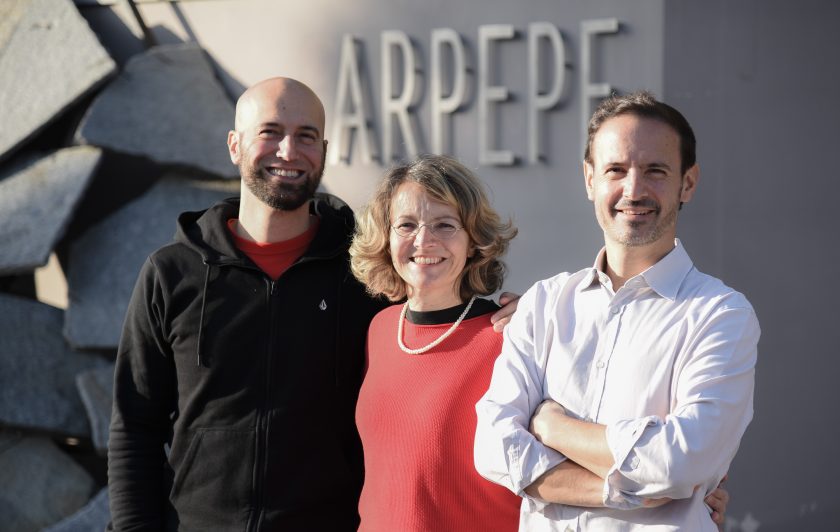2016 ARPEPE Rosso di Valtellina MAGNUM
This is alpine Nebbiolo like you’ve never had before — finessed, smooth, the more delicate side of the grape made famous for its power in Barolo. This bottling is from the 5th generation Ar.Pe.Pe estate in northern Italy’s Valtellina, Lombardy (on the border with Switzerland).
Sustainable farming practices and 4,000 cases produced annually.
- Tasting Notes strawberry, red cherry, hibiscus tea, white pepper, peppermint, leather
- Variety 100% Chiavennasca (Nebbiolo)
- Region Italy, Lombardy
- Volume 1.5L
- Alcohol Volume 12.5%
- Table Talk The terraced vineyards of ARPEPE are tucked in between the Orobic and Retic Alps just south of the Italian-Swiss border.

“These wines from ARPEPE (an abbreviation of founder Arturo Pelizzatti Perego’s initials) are among the most impressive I tasted… From top to bottom, the wines are deserving of serious attention. The super-traditional style will leave lovers of translucent Nebbiolo weak at the knees… Perhaps most importantly, ARPEPE shows just how pedigreed the wines of Valtellina can be.” — Antonio Galloni, Vinous
Tucked in between the Orobic and Retic Alps just south of the Italian-Swiss border, you’ll find the terraced vineyards of ARPEPE. At the helm of this storied estate, located in the Grumello subzone of Valtellina in Lombardy, is the fifth generation of the Pelizzatti Perego family. The roots of this blue-chip estate go back to the 1860s, when the current generation’s great-great-grandfather Giovanni founded a successful winery in the area, then known only as “Pelizzatti.” Over 150 years of history have passed since then, including the dark days of the 1970s during which the current generation’s grandfather fell ill, and the family was forced to sell the Pelizzatti brand along with some of their vineyards. The more recent history of the estate is an almost deus-ex-machina turn of events: the family re-founded their company under the ARPEPE label in 1984, got back many of their proprietary vineyards from renters, and were able to reclaim their cellar in Grumello. Today, ARPEPE is widely recognized as the single best producer in the appellation (as well as a benchmark producer of Nebbiolo in general) and we couldn’t be more thrilled to bring them to our customers.
Related Items
-
2023 Scribe Carneros Pinot Noir
$55.00Scribe, a pioneer of terroir-driven winemaking in Sonoma, makes one of our all-time favorite Pinots. Invite a few close friends over for an intimate dinner, light some candles, play some jazz and serve wild mushroom risotto topped with fish, chicken or as is! This Pinot will go with it all.
Organic farming practices, hand-harvested, native yeast fermentation (30% whole cluster), and aged 7 months in neutral oak with minimal intervention.
-
2022 Bachelet-Monnot Santenay Blanc
$65.00Made by one of Burgundy’s most respected producers, this bottle is ideal for those who appreciate well-made Burgundy Chardonnay with a perfect balance of power and finesse. Santenay, known for its full-bodied whites, pairs wonderfully with a wide range of dishes thanks to the balance of richness and acidity in the wine. Enjoy with grilled scallops, lobster, roasted chicken, creamy pasta dishes, and soft cheeses like Brie or goat cheese.
Biodynamic farming practices, hand-harvested 30+ year-old vines, native yeast fermentation and aged for 12 months in barrel (12% new).
-
2018 Domaine Alain Burguet Chambertin ‘Clos de Bèze’ Grand Cru
$600.00If you know, you know. ‘Clos de Bèze’ is the most prestigious and sought-after Grand Crus in Gevrey-Chambertin. For collectors, this wine is a great investment. It will only continue to appreciate in value as it ages over the next 10-20 years.
Practicing organic viticulture, hand-harvested, native yeast fermentation, unfined/unfiltered and only 100 cases produced.
-
2023 Domaine Marc Portaz Vin de Savoie ‘Apremont’ Tête de Cuvée
$22.00This crisp white from the French Alps is a true Apres Ski! France’s most mountainous region, the vines are 30 to 50-years-old and grown on the site of an ancient avalanche. It has similar fruit aromas to Sancerre and flavors as complex and mineral-driven as Chablis.
Sustainable farming practices, hand-harvested and native yeast fermentation.






